
Fast, affordable Internet access for all.

As the Georgia legislature considers HB 282, a bill that will restrict local governments from investing in telecommunications networks, we are continuing coverage of the communities that will be harmed by passage of the legislation.
Should the restrictions become law, existing networks will not be able to expand. No expansion means fewer opportunities to reap the benefits that flow naturally from community networks. While this means few residents will receive access in places like Thomasville and Moultrie, it also means fewer businesses will receive access in places where networks exclusively serve commercial customers and government offices.
LaGrange's IT Director, Alan Slaughenhaupt, told us a little about its municipal network that began in 1996. The community decided to build its own network when no private provider would. The first goal was to get the K-12 schools connected. Bonds funded the network build out and were paid off within five years. At the time, the city partnered with ISN (Later Earthlink) to get the schools connected. LaGrange now partners with Charter Communications to bring connectivity to students.
The LaGrange network now connects hospitals, most city, county, and state government facilities, and provides connectivity for businesses. Alan describes how a T1 connection cost local businesses $2,300 per month in 1996. Now, thanks to competition created by the community owned network, local businesses can pay just $100 for a connection with better capacity. The municipal network serves about 400 commercial customers.
Alan explained that the automaker Kia moved a manufacturing facility near LaGrange in 2009 that used Just-In-Time inventory control. It needed a high-speed connection between the main plant and suppliers that LaGrange could deliver.
Fremont Public Schools and the City of Fremont are joining forces to bring better connectivity to students and government. According to a Fremont Tribune article, work has already started on a fiber optic project that will increase bandwidth for both entities.
Fremont is a few miles northwest of Omaha and checks in with over 25,000 residents.
The schools will move from a 40 Mbps Internet connection to 10 Gbps. While each entity will own their own strands, they will share paths throughout the city. From the article:
“The benefits are going to be huge to the schools and the city,” [Heather] Tweedy, [media representative for Great Plains Communication] said.
The city and school district each will own their own strands, but will share paths throughout the city.
For example, the city would need to run a connection from the municipal building on Military Avenue to the power plant on the southeast side of Fremont, a path that also would go near Grant and Howard elementary schools.
The school district then would be responsible to get the fiber optics from the power plant to Fremont Middle School and Johnson Crossing Academic Center.
According to the article, Great Plains will do the install at a cost of $246,000 to the school and $149,000 to the city. We generally find that these types of arrangements result in tremendous cost savings for all entities involved.
Even as the Internet is changing every aspect of our lives and communities, most Americans are intimidated by confusing jargon and misconceptions about Internet policy. We are developing a series of fact sheets that make these issues understandable to everyone.
We presently have fact sheets from the Institute for Local Self-Reliance and other organizations that cover broadband, financing networks, wireless Internet, economic development benefits from community owned networks, and the public savings from community owned networks.
Stay up to date with these fact sheets and other developments in community owned networks, subscribe to our one-email-per-week list. Once a week, we send out an update with new stories and resources.
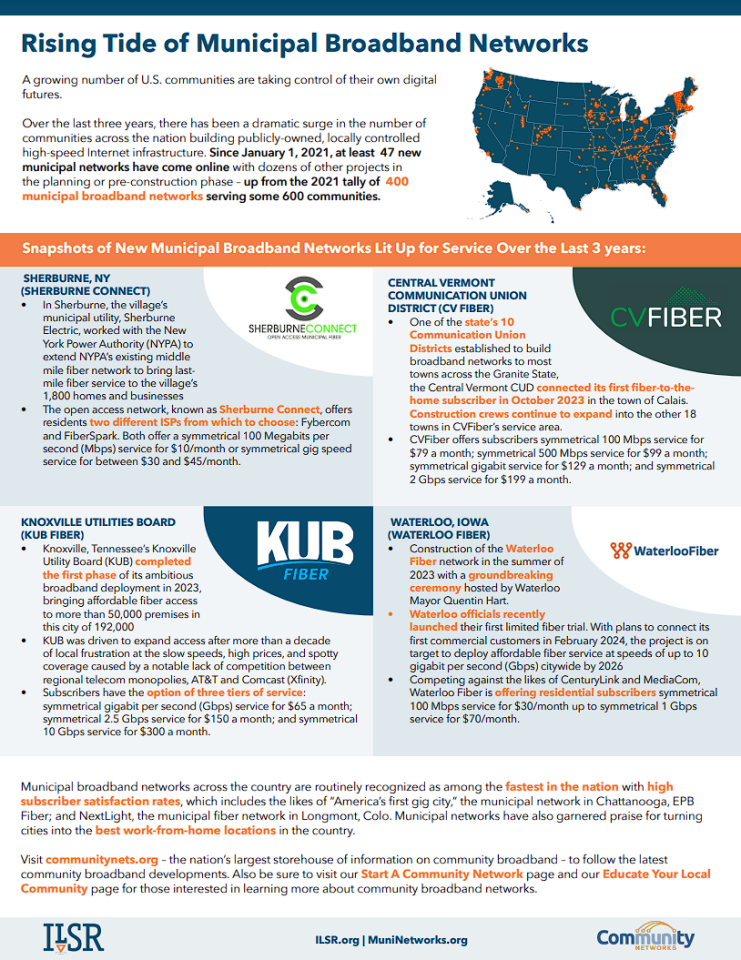
The municipal broadband movement continues to gain momentum. Since January 1, 2021, at least 47 new municipal networks have come online with dozens of other projects still in the planning or pre-construction phase, which includes the possibility of building 40 new municipal networks in California alone. To help encapsulate this dramatic surge in the number of communities building publicly-owned, locally controlled high-speed Internet infrastructure, we created this fact sheet to provide pertinent numbers and highlight four recently launched networks now providing service to communities hungry for high-quality Internet connectivity, choice, competition.
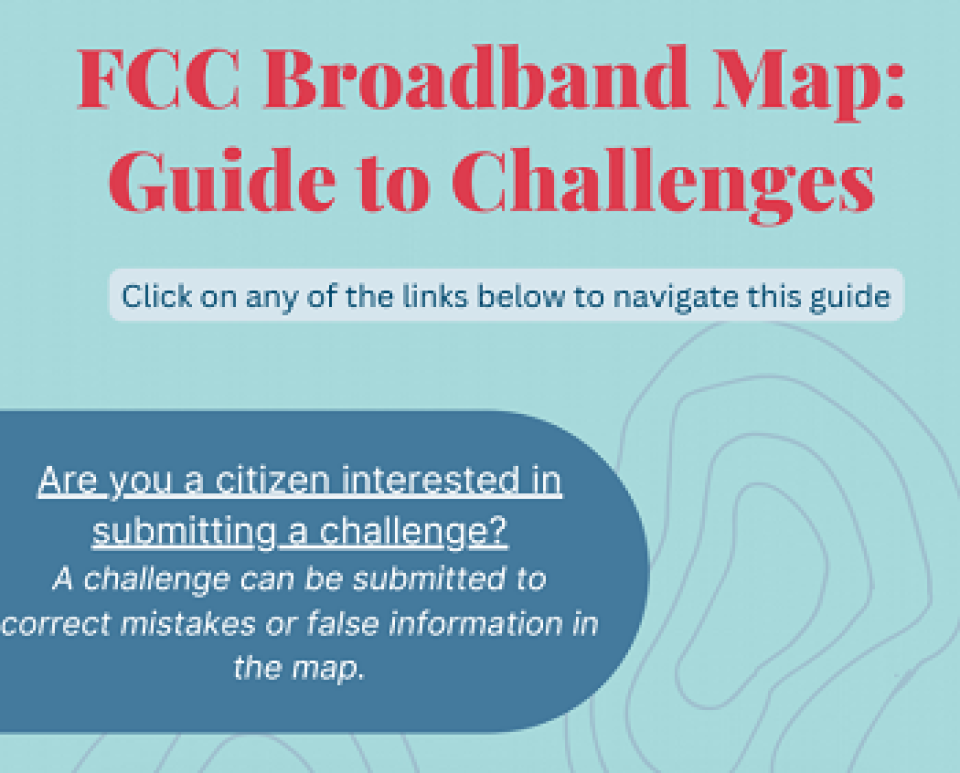
With good reason, many are confused about the information shown in the FCC's new Broadband Availability map, the challenge process, and why we should care about helping the FCC make corrections. We believe it is important to contribute to improving this map to enable an equitable allocation of Broadband Equity, Access, and Deployment (BEAD) Program funds to states next year. In an effort to provide a better understanding of the map itself and the challenge process we created a short series of instructional videos and a click-through guide. FCC Broadband Map Challenge Guide [pdf]
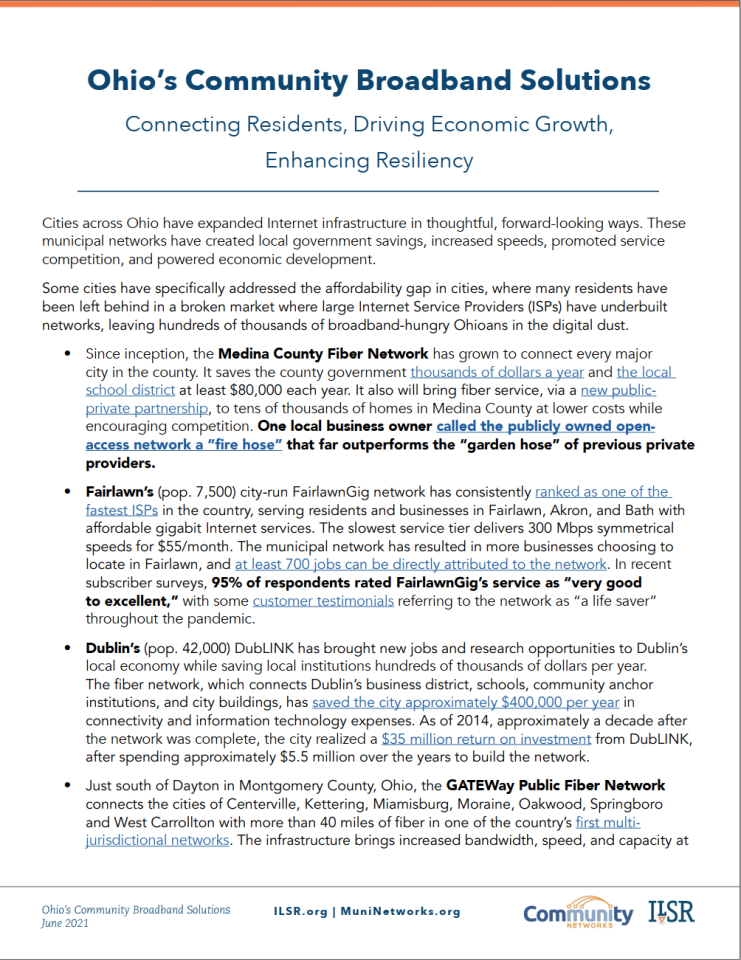
Cities across Ohio have expanded Internet infrastructure in thoughtful, forward-looking ways. These municipal networks have created local government savings, increased speeds, promoted service competition, and powered economic development. Some cities have specifically addressed the affordability gap in cities, where many residents have been left behind in a broken market where large Internet Service Providers (ISPs) have underbuilt networks, leaving hundreds of thousands of broadband-hungry Ohioans in the digital dust. This fact sheet outlines the many long-term benefits that municipal broadband projects have brought to the state.
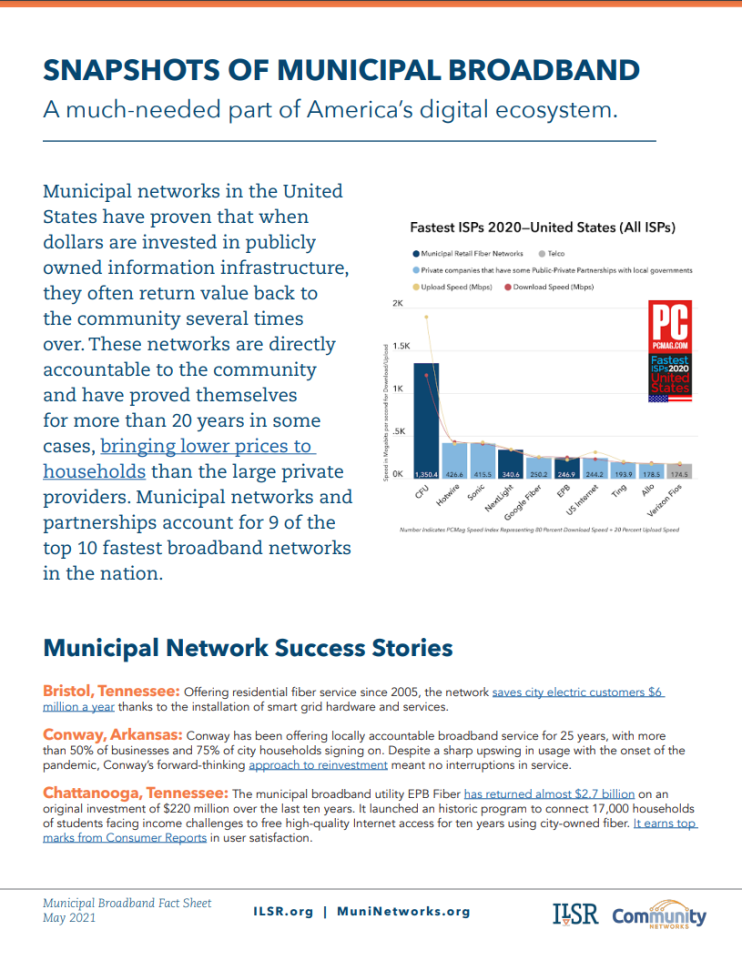
Municipal networks in the United States have proven that when dollars are invested in publicly owned information infrastructure, they often return value back to the community several times over. These networks are directly accountable to the community and have proved themselves for more than 20 years in some cases, bringing lower prices to households than the large private providers. Municipal networks and partnerships account for 9 of the top 10 fastest broadband networks in the nation. This new fact sheet highlights municipal broadband success stories from across the country and some of the many benefits the networks have brought to the communities they serve.
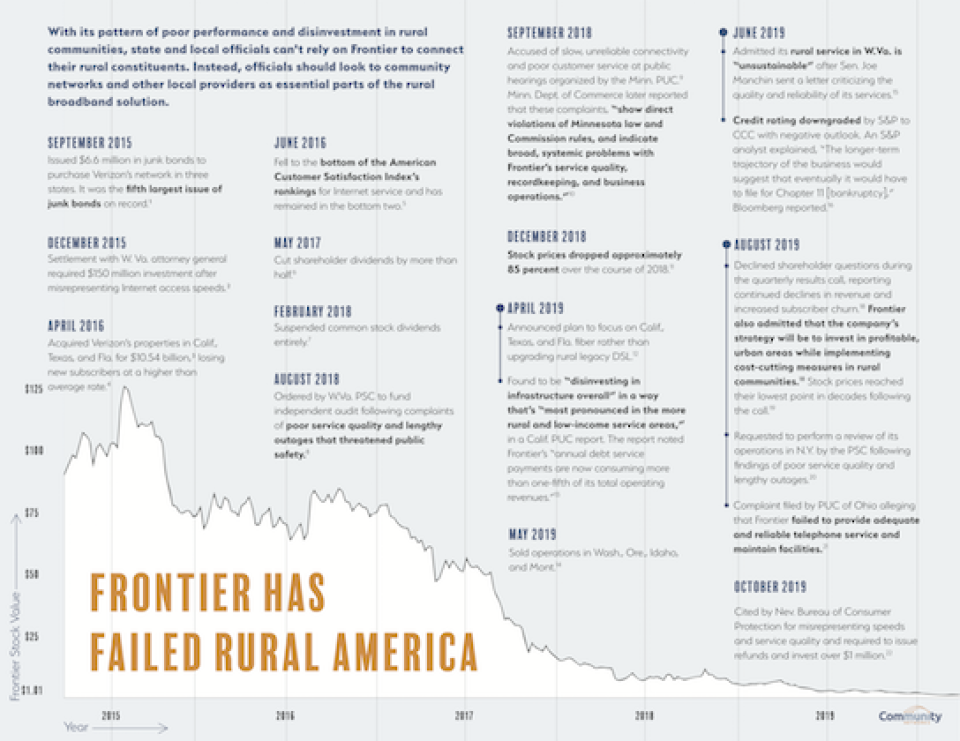
Despite raking in hundreds of millions in government broadband subsidies, Frontier Communications has failed time and time again to bring reliable, high-speed connectivity to the rural communities it serves. Instead of investing in network upgrades, Frontier has neglected its rural infrastructure to the detriment of its subscribers and the company’s own financials, with its worsening service quality paralleling its plummeting stock value. This fact sheet presents evidence of Frontier’s negligence and suggests that rather than continuing to trust Frontier, government officials should look to publicly owned and community-minded providers to connect rural residents, businesses, and institutions.
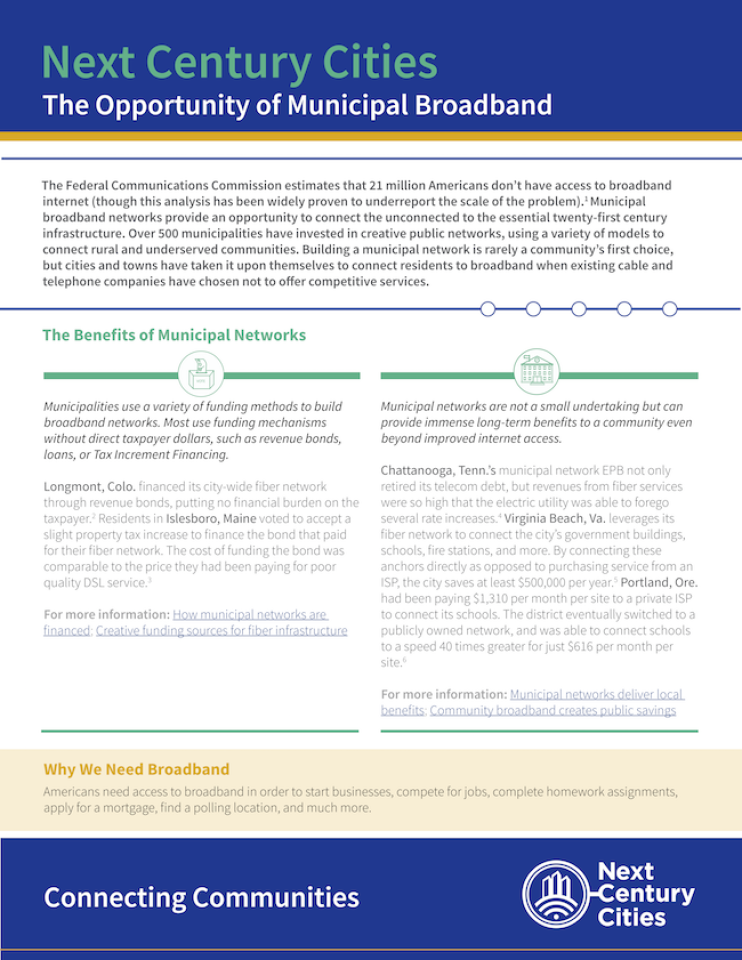
Next Century Cities (NCC) helps communities across the U.S. connect to each other, find resources, and discover ways to improve local Internet access options. NCC’s fact sheet uses examples from municipal network history. Communities have invested in publicly owned fiber optic infrastructure to obtain better connectivity and to reduce telecommunications costs for municipal facilities. In more than a few places, those investments became the foundation for what later became networks to serve local businesses and residences. The fact sheet also delves into other benefits, such as economic development, improved efficiency of other utilities, and accountability.
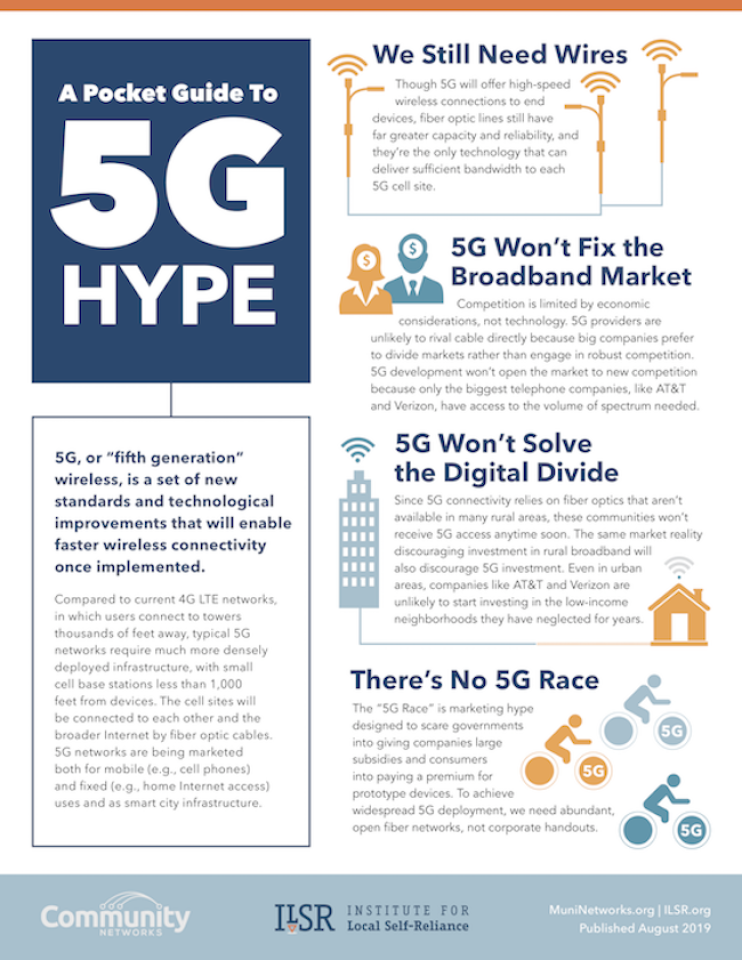
It’s difficult to separate 5G fantasy from reality as reported in traditional news sources. Misunderstandings surrounding the demands and capabilities of 5G has snowballed, creating an incorrect assumption that the technology will solve America’s many connectivity problems. It’s true that 5G is an improvement, but it has limitations. This fact sheet addresses the most repeated errors surrounding 5G and explains why the technology should be considered another tool, not an exclusive remedy.
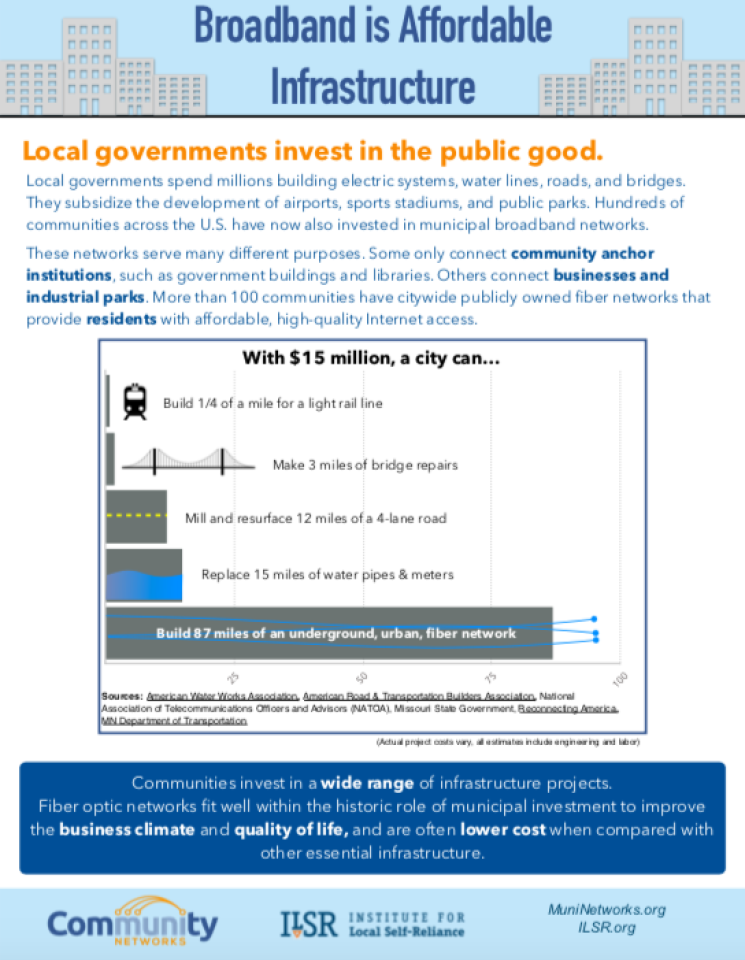
Local governments spend billions on all sorts of infrastructure every year to advance the public good for their communities. Roads and bridges keep day-to-day activity moving. Investments such as water and sewer infrastructure keep cities clean and livable. Fiber infrastructure is used for a wide range of purposes, including economic development, education, and to keep a city’s administration connected. To get a look at how fiber network infrastructure compares to other public investments, we've developed the Broadband is Affordable Infrastructure fact sheet.
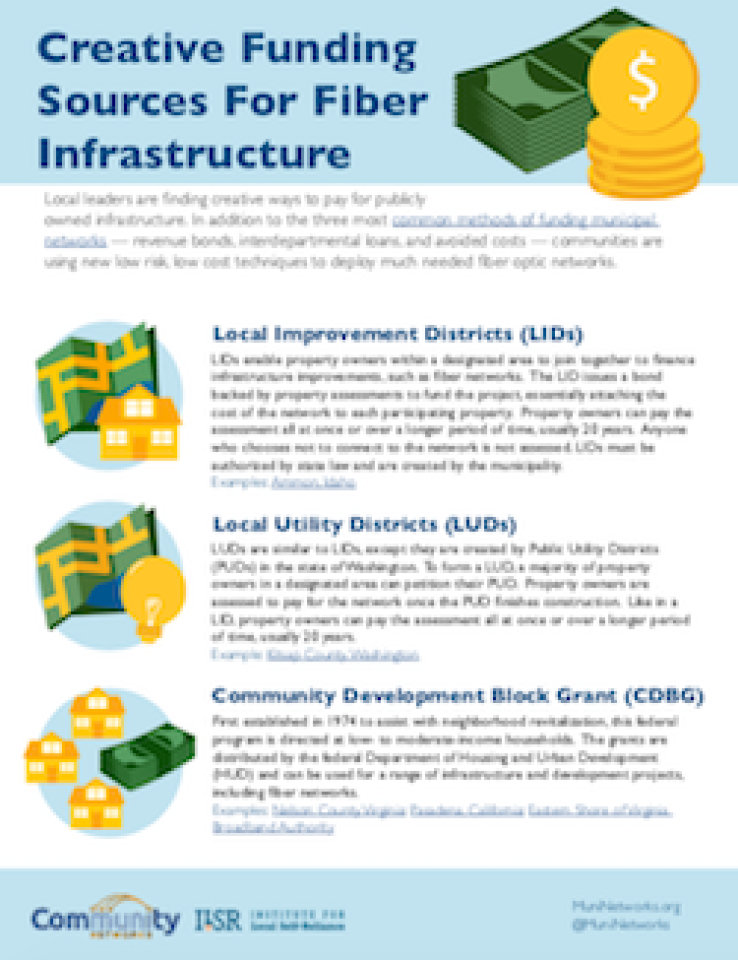
As interest in publicly owned broadband network infrastructure increases, local communities seek new ways to fund municipal networks. Revenue bonds, interdepartmental loans, and avoided costs have been the three most common methods for funding Internet network infrastructure, but local leaders are finding creative approaches to get the job done. In this fact sheet we analyze some new approaches to funding fiber optic infrastructure, pros and cons, and offer some examples.
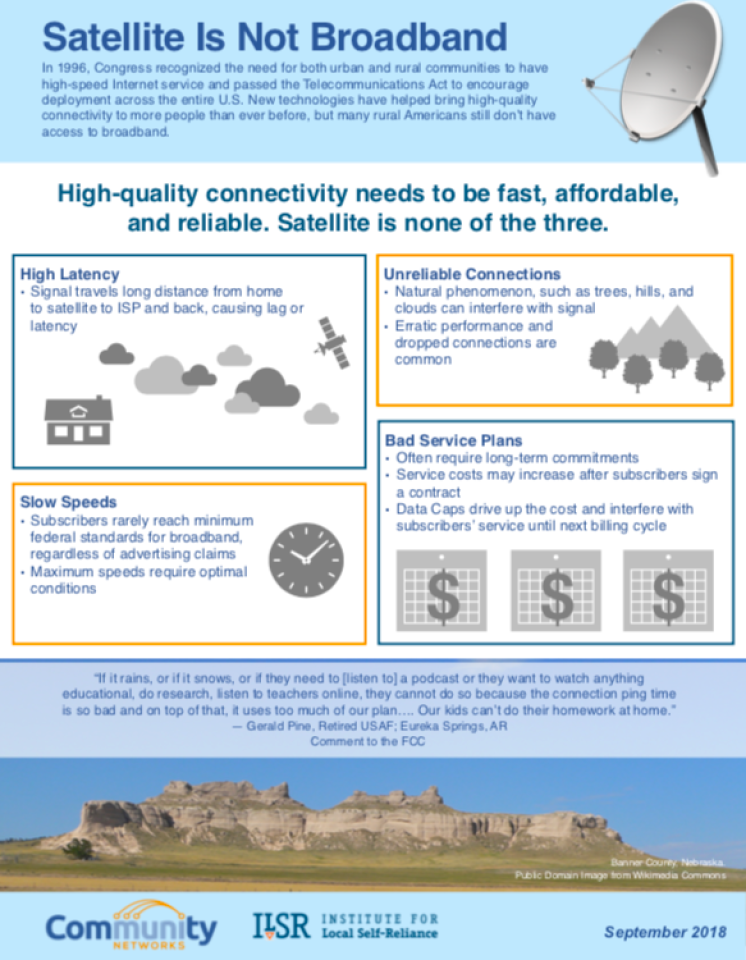
As a nation our goal is ubiquitous broadband coverage so every person, regardless of where they live, can obtain the fast, affordable, reliable Internet access necessary for modern times. For people in rural areas, where large national wireline providers don’t typically invest in the infrastructure for high-quality connectivity, satellite Internet access is often their only choice. In this fact sheet we address some of the reasons why depending on satellite Internet access to serve rural America is a mistake.
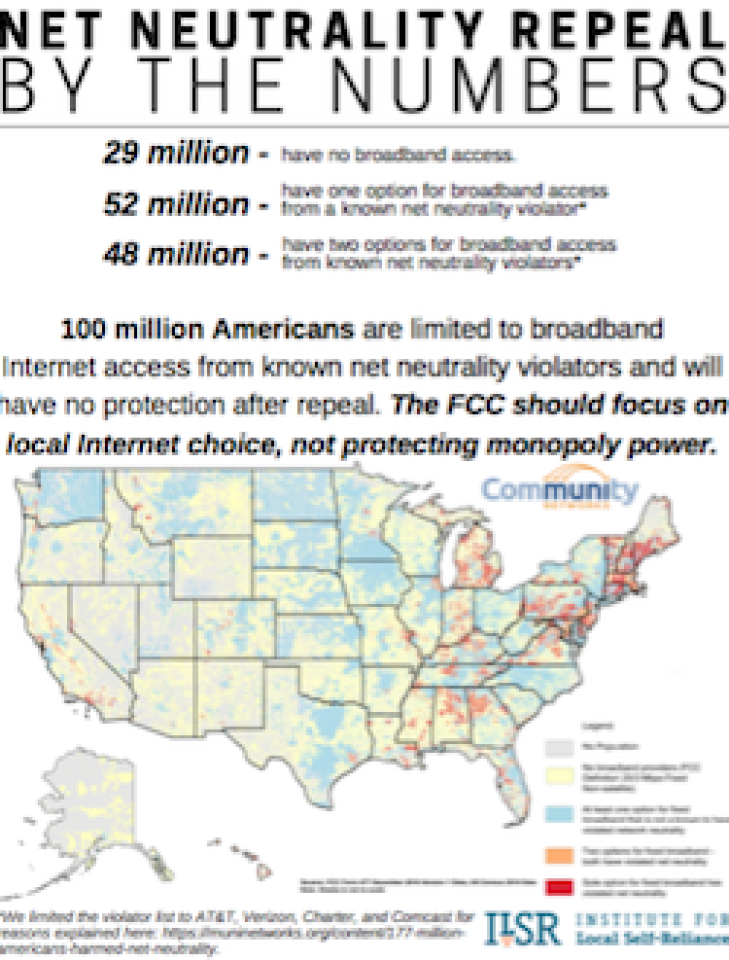
As the vote to repeal network neutrality protections approached in 2017, we started digging into the FCC’s data to determine how eliminating the policy would affect subscribers whose ISPs might take advantage of future changes. We learned that, due to existing monopoly and duopoly conditions, many millions of people would have no recourse but to pay known network neutrality violators for Internet access. We developed visuals and facts sheets with frank data that describes the problem in the U.S., California specifically, and on the East Coast from Maine to Virginia.
Net Neutrality Repeal By The Numbers, U.S.A. Edition fact sheet [pdf].
Net Neutrality Repeal By The Numbers, California Edition fact sheet [pdf].
Net Neutrality Repeal By The Numbers, East Coast Edition fact sheet [pdf].
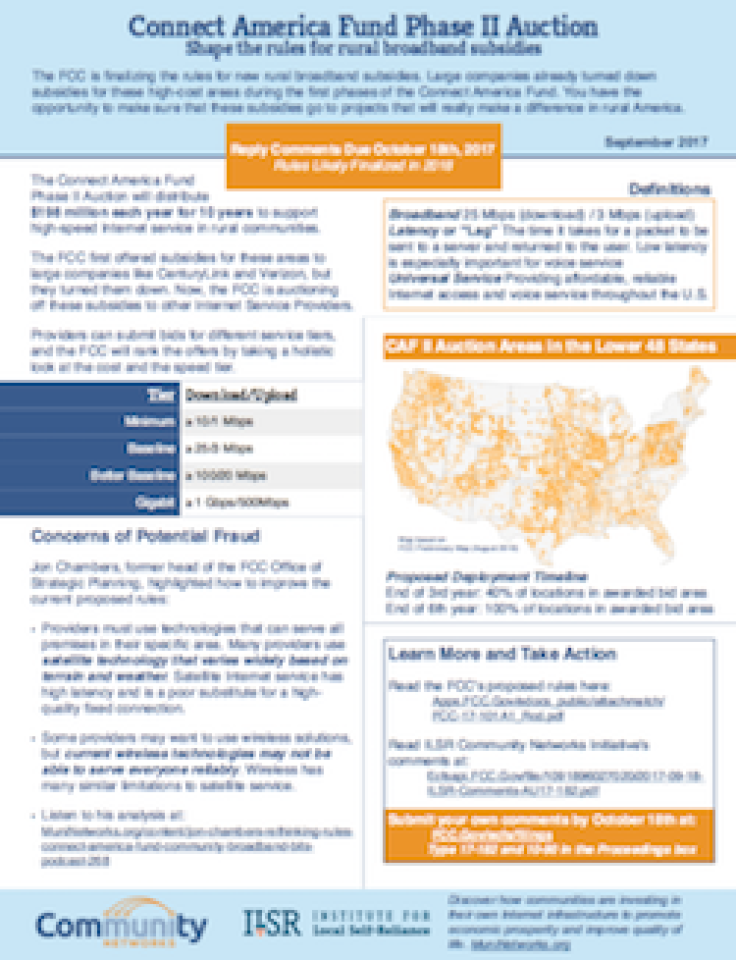
The Federal Communications Commission (FCC) manages the CAF program, which provides billions of dollars in subsidies to Internet service providers for areas where the cost of building networks is prohibitive. Some large providers decided not to accept some of the subsidies during Phase I - about $198 million annually for 10 years. This fact sheet details the most important aspects of the Connect America Fund (CAF) Auction. What is it? What should it do? Who does it affect?
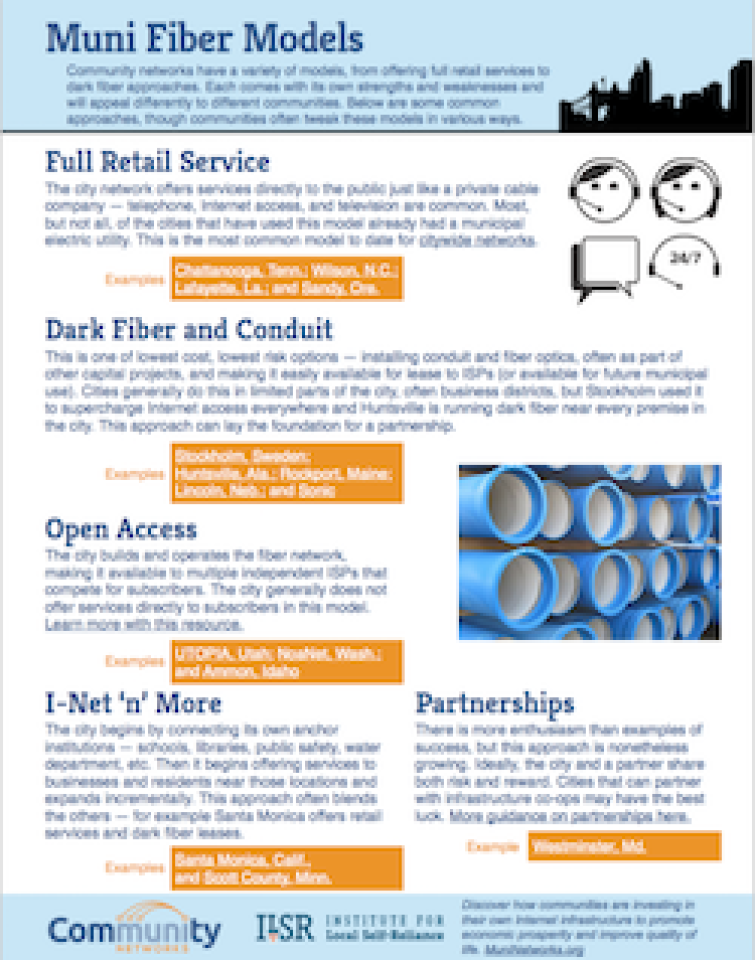
When you think “municipal fiber network,” you may think Chattanooga or Wilson, North Carolina - places where the city utility offers retail services directly to subscribers. That’s only one of several possible models that are emerging as an increasing number of communities use publicly owned assets to improve local connectivity. This fact sheet offers five of the most well known models that local governments are investigating and implementing as they become more self-reliant. Examples and characteristics of each model help illustrate.
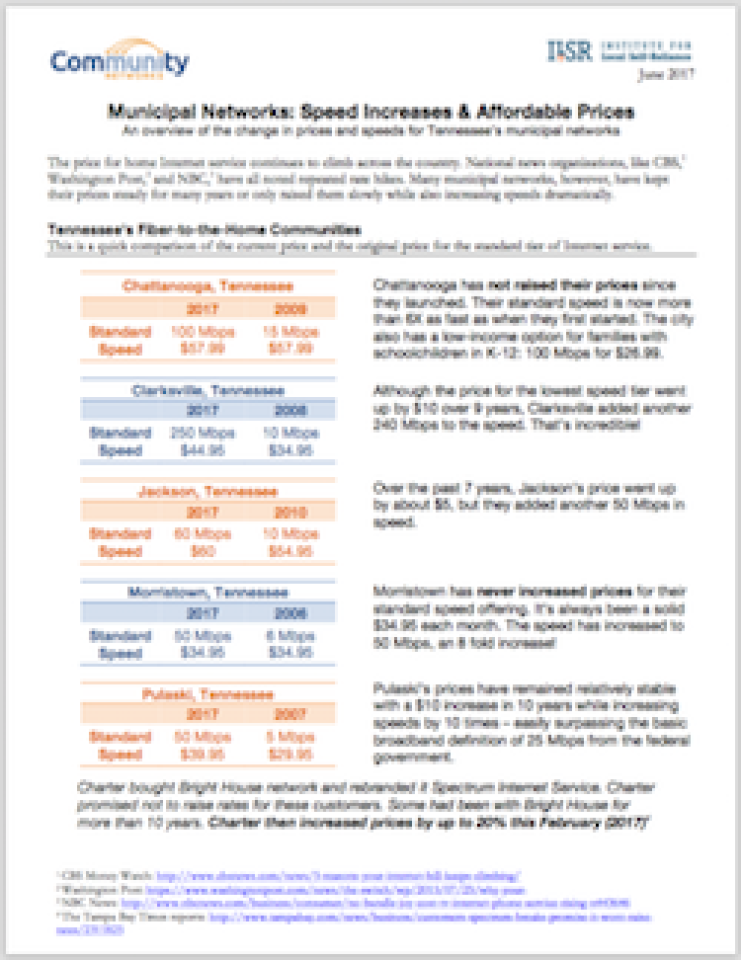
The large corporate national Internet Service Providers seem to raise their monthly rates every year but don’t give subscribers anything more for their money. On the flip side, we noticed that municipal networks tend to increase speeds for subscribers with very modest or no price increases over long periods of time. In order to illustrate this phenomenon, we looked back in time at rates and speeds in eight Tennessee communities that have invested in publicly owned Internet network infrastructure. You will see how speeds have increased significantly, but rates have only inched up.
Municipal Networks: Speed Increases & Affordable Prices [pdf]
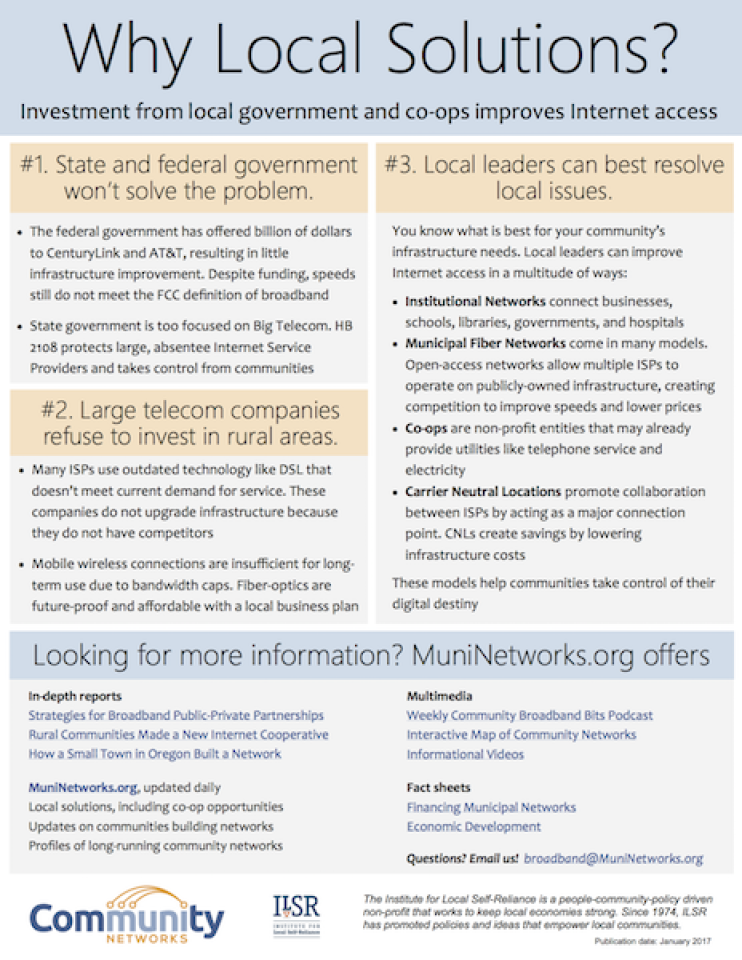
The next time you’re attending a city council meeting, a local broadband initiative, or just chatting with neighbors about better local connectivity, take a few copies of our fact sheet. In addition to providing some basic talking points to get the conversation moving, the fact sheet offers resources to guide you to more detailed information on publicly owned Internet networks. You've already started to get people interested in all the advantages of high-quality connectivity, now show them how local self-reliance it the most direct route to better access.
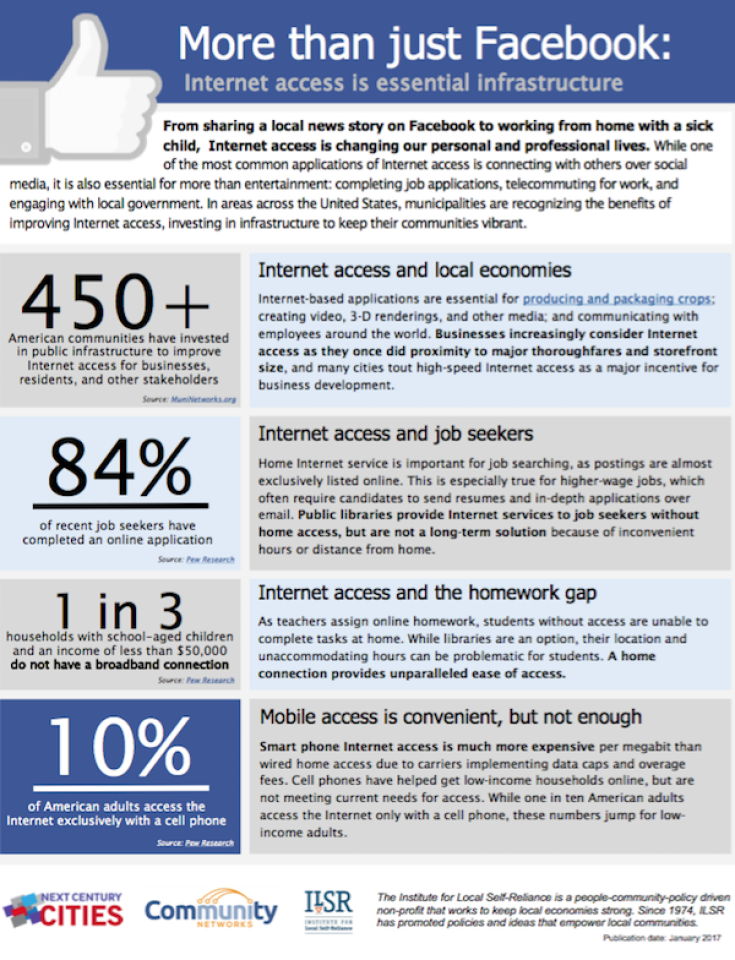
This fact sheet provides an overview on how Internet access and fast, affordable, reliable connectivity reaches most aspects of our lives. It provides statistics on economic development, education, and methods of delivering Internet access and is a good introductory tool that points out how Internet access is much more than just social media.
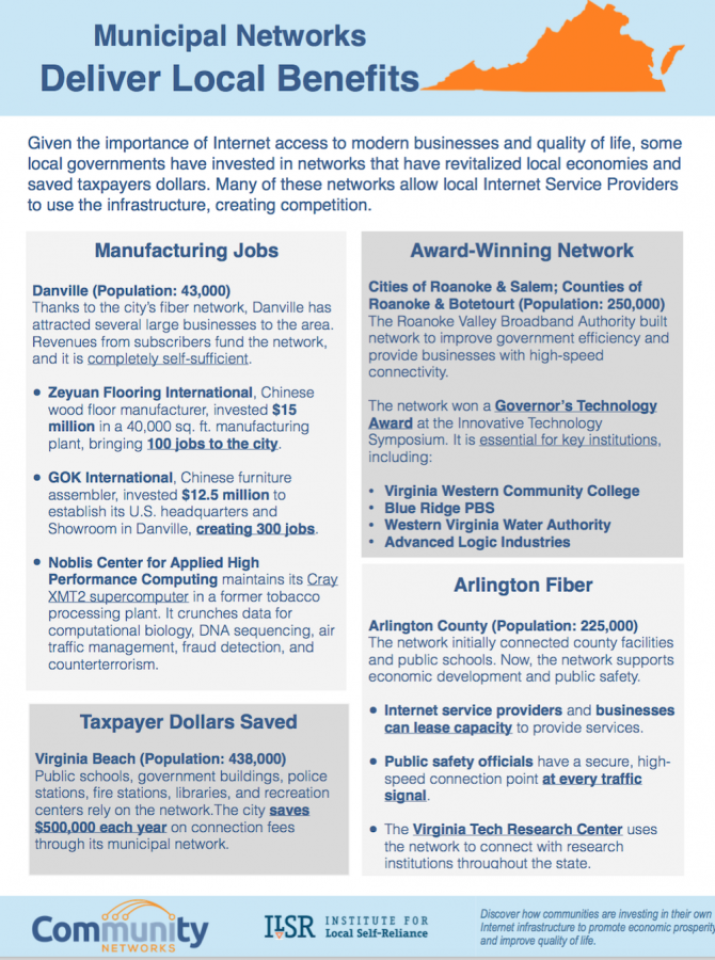
This fact sheet on municipal networks in Virginia describes how economic development, public savings, and better connectivity have contributed to the health of local communities with publicly owned networks. Virginia local governments have improved public safety, healthcare, and connectivity in local schools. Rural areas are better able to compete for high-tech and manufacturing jobs because high-speed connectivity is now an essential service for day-to-day business.
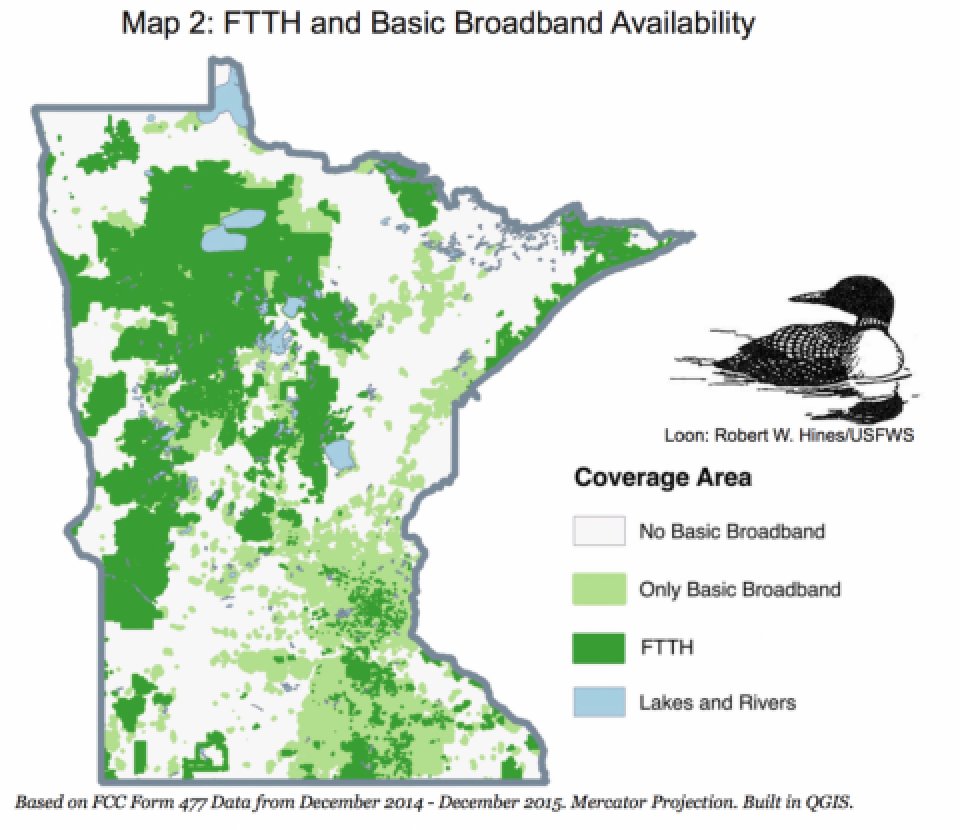
This fact sheet highlights the great work that Minnesota cooperatives and municipalities have done to bring fast, affordable, reliable Internet service to rural areas throughout the state. They've built many Fiber-to-the-Home (FTTH) networks, but there is still much work left to do. One in 4 Minnesotans lives in a rural area, and of those rural households, 43 percent lack access to broadband, defined by the FCC as 25 Megabits per second (Mbps) download and 3 Mbps upload. Resilient, robust, fiber is the long-term goal, but fixed wireless can help extend coverage in hard-to-reach rural areas.
Minnesota Cooperatives and Local Governments Can Solve Rural Digital Divide[pdf]
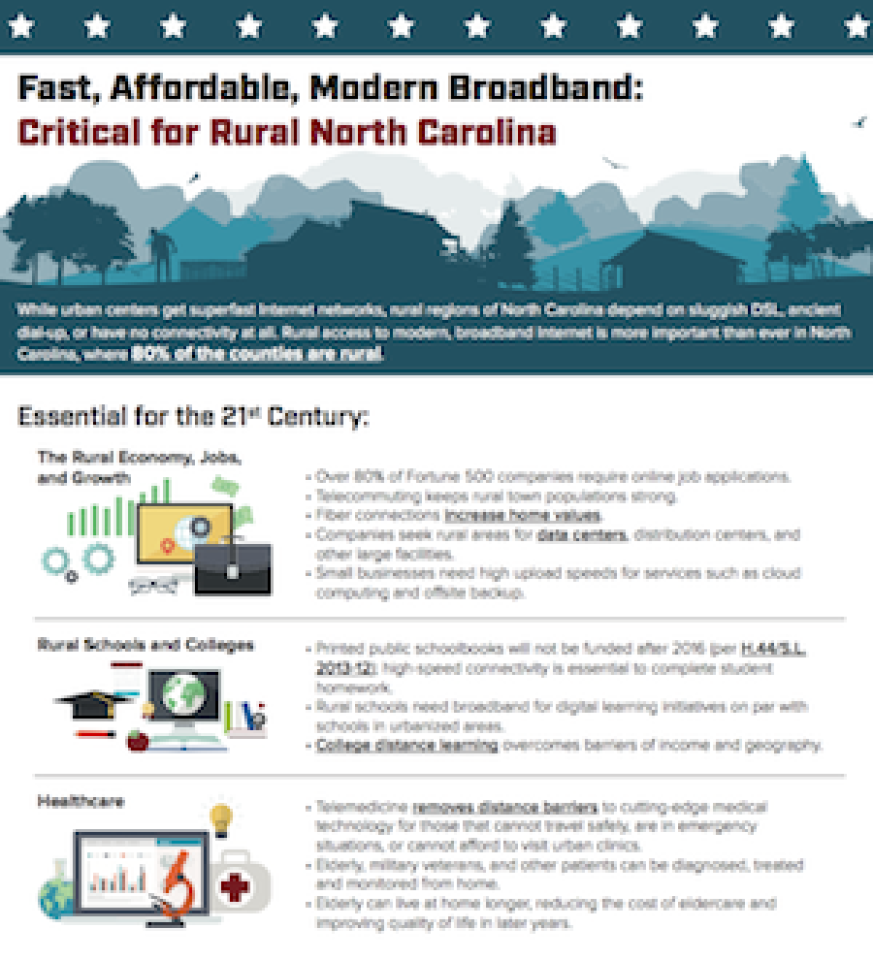
This fact sheet emphasizes the deepening divide between urban and rural connectivity. The fact sheet can help describe why people who live in the country need services better than DSL or dial-up. This tool helps to visualize the bleak situation in rural North Carolina, how it can be improved, and offers links to resources.
Fast, Affordable, Modern Broadband: Critical for Rural North Carolina [pdf]
Communities across the nation have invested in publicly owned cable and fiber infrastructure. ILSR's Community Networks Map documents over 500 communities where municipal networks serve residents and businesses. This fact sheet provides a quick introduction to the interactive online map.
When a community decides it needs to establish its own publicly owned network infrastructure, one of the biggest challenges is financing the investment. Each community is unique but three main methods of financing are most popular. This fact sheet offers a quick look at these common approaches and provides real-world examples.
This is a handy resource for elected officials and activists that are confused by some of the jargon or just want to make sure they understand some key ideas around broadband and telecommunications.
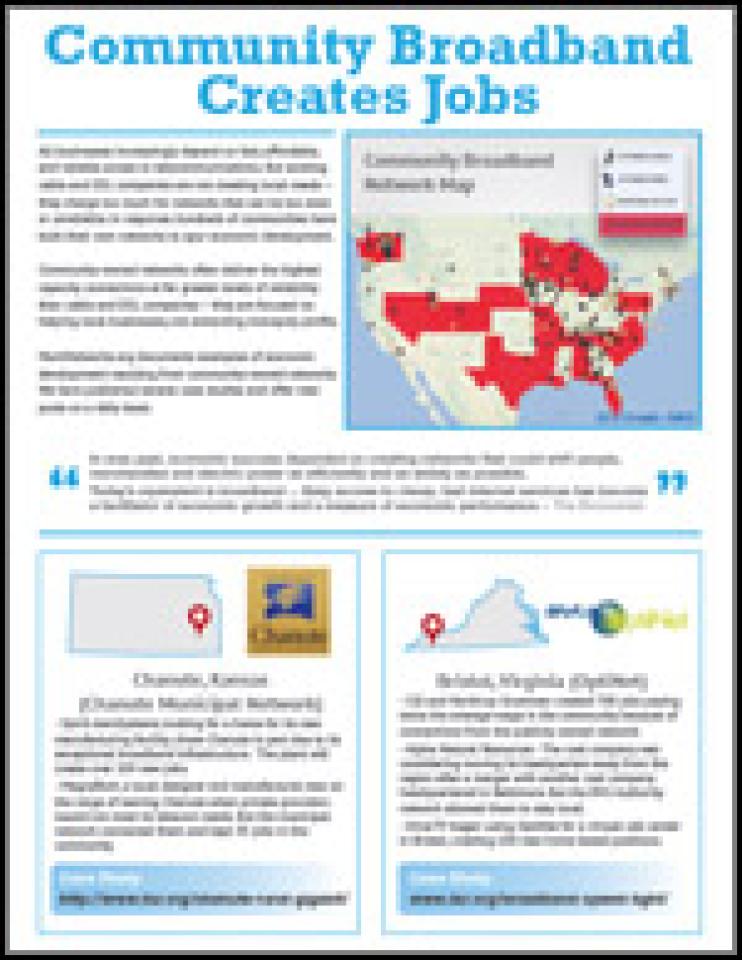
Community Broadband Networks have a very good track record in creating jobs. This fact sheet details where publicly owned network attracted new businesses or helped existing businesses to thrive.
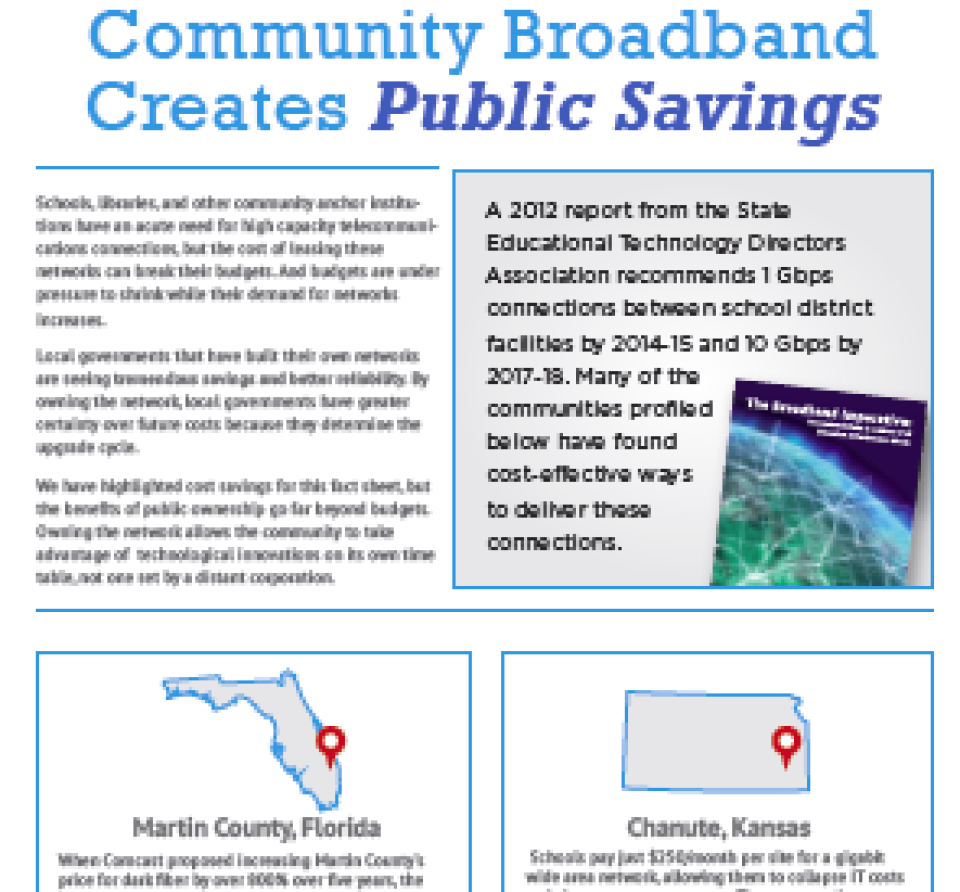
Though schools, libraries, and other community anchors need access to faster, more reliable networks, the big cable and telephone companies have priced those services so high that they are breaking the budget. But when communities create their own connections, affordable high capacity connections aren't the only benefits.
Wireless networks may appear to be magical, but are actually driving investment in fiber optic wires. This resource defines many terms, key points, common speeds, and offers insight into wireless technology and policy.
This 2 page fact sheet explores the issue of preemption - how at least 19 states have made it impossible or more difficult for communities to build their own networks. It includes some history, legal issues, and quotes from FCC Commissioners.
Kudos to Richard Downey, Village Administrator for the Village of Kronenwetter in Wisconsin. Mr. Downey reminded us that we have yet to write about the fiber network in Princeton, Illinois. While we have noted Princeton in our list of economic development successes, we haven't delved into the network that serves the city, the schools, and the business community.
Princeton is home to about 7,500 people and is located in the north central region of the state in Bureau County. They have their own electric, water, and wastewater utilities and began offering broadband connectivity in late 2003. We spoke with Jason Bird, Superintendent of Princeton Electric Department, who shared the network's story with us.
In 2003, the city’s largest electric and water consumer was also the largest employer. At the time, incumbents served the community with T1 connections. The manufacturing company moved to Mexico, taking 450 jobs with it. The community was stunned.
Approximately 6 months later, Ingersoll Rand, the community's second largest employer with about 300 jobs, also considered moving away from Princeton. While lack of needed broadband was not the only reason, the Ingersoll Rand CEO let community leaders know that it was one of the influential factors. The company liked being in Princeton, and the city would have been on the top of the location list if not for the sad state of connectivity. At the time, the only commercial option was unreliable T1 connections for $1,500 - $2,000 per month. If Ingersoll Rand moved, the community would experience job losses equal to 10% of the population. Community leaders needed to act and do it quickly.
To retain Ingersoll Rand, the City Council decided unanimously to go into the telecommunications industry. They issued an RFP and encouraged incumbents AT&T and Comcast to bid; neither were interested. (Interestingly, once Princeton let it be known that they were going to build the network without them, there were some local upgrades from both companies.)
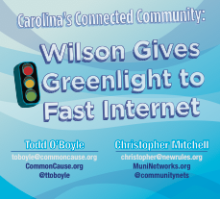
We have already published a fact sheet on the critical role community broadband plays in job development. Now, ILSR presents a collection of how community owned broadband networks save money for local government, schools, and libraries while providing cutting edge services. The Public Savings Fact Sheet is now available.
Though schools, libraries, and other community anchors need access to faster, more reliable networks, the big cable and telephone companies have priced those services so high that they are breaking the budget. But when communities create their own connections, affordable high capacity connections are only one of the benefits. A community owned network offers the promise of self-determination -- of upgrades on the community's time table and increased reliability for emergency responders.
The Public Savings Fact Sheet is a great piece to share to mobilize other members of your community. Share it with decision makers and use it to start meaningful conversations. Distribute it widely and often.
We are always developing new resources. If you have an idea for a new fact sheet, we want to hear it.
Last year, we reported that ECFiber was in the process of connecting rural Vermont, with a focus on connecting those who had no access to broadband. In addition to large investments from a limited number of investors, local citizens began lending funds to expand the network.
In a recent open letter to the Governor, published in the Barre Montpelier Times Argus, Laura Zantzinger from Barnard describes how ECFiber touches her household. Zantzinger's home tech company can now expand because she has the capacity she needs from ECFiber. Zantzinger also discusses how fiber access helps her son academically:
My son attends an online high school in a program offered through one of the top universities in the country. He attends video conference classes, lectures, meetings, and myriad other communications online to California, and places all over the globe.
Two years ago, we moved out of state, renting a house elsewhere to get the Internet, because my son was not able to participate in class. His grades suffered because of it. Last year, we rented an office in another town where Internet was available.
Zantzinger describes two growing trends - home based businesses and distance learning - that require access to broadband. Zantzinger shares strong words of praise for ECFiber's mission, experienced by her first hand:
ECFiber’s approach has been open and community-oriented. They just want to get it built, pay it off, and hand it over to the towns. They are willing to make things work, even if it is hard, if it means they can serve the customer. Their priorities as expressed in the meetings were amazing to me.
According to the ECFiber blog, funding is moving forward to bring the network to neaby Woodstock. From the blog:
Last summer, Medina County Schools announced a savings of almost $90,000 a year by switching from Time Warner Cable to the new Medina County Fiber Network. Scheduled for completion in late November, the network consists of a 151-mile loop and will provide bandwidth to government facilities and businesses. The project is mostly funded by the Medina County Port Authority, which will own the loop, and receives support from a stimulus broadband grant administered by the NE Ohio nonprofit, OneCommunity.
Loren Genson reported on local businesses' enthusiasm as the network makes its way to Brunswick, where fiber will pass through the Brunswick Industrial Park. Genson attended a meeting to update the community. From the article:
LeHotan, who owns All Construction Services on Industrial Parkway North, said improved fiber-optic broadband speeds will keep business in the industrial park and recruit new businesses to the area.
...
Brunswick Economic Development Director Tim Smith said he promotes the fiber-optic network when talking to businesses interested moving their operations to Brunswick.“I see leads that come in, and one of their requirements is high-speed broadband,” Smith said. “Our industrial park is right on the throughway. … Now we have this to offer as well.”
Clearly, current and potential Medina County employers recognize the value of the network. Dave LeHotan, owner of a local construction company, spoke at the gathering:
“It’s like a garden hose: You can only get so much water out of it, so much use at a time,” he said. “But this is like a fire hose, much more powerful.”
LeHotan said getting the upgraded infrastructure will help attract more businesses not only to Brunswick but all along the two loops that connect the entire county.
“This is really necessary even for small companies,” LeHotan said. “You can form a small company and all of a sudden the next thing you know you’re shipping 1 million products and only 15 percent of them are nearby.”
The nonprofit Merit Network, Inc., of Michigan, started in 1966 as a way to provide networking help to the state's research and educational facilities across the state. Over the years, the organization has kept up with the times and is now spearheading the Rural, Education, Anchor, Community and Healthcare - Michigan Middle Mile Collaborative (REACH-3MC II) project.
The project will bring connectivity to community anchor institutions and underserved rural communities in the Upper and Lower Peninsulas. The exentive fiber project is funded with two Broadband Technologies Opportunities Program (BTOP) grants totaling $103.2 million. When completed, Upper and Lower Michigan will house an additional 2,287 miles of fiber.
Matt Roush recently reported on the project, which is well underway in Monroe County in the southern part of the state. Roush brought news about installation of telecommunications huts, an early step in expanding the network into northern Michigican. From the article:
REACH-3MC will connect 105 community anchor institutions as the network is built and will pass 900 more over time. Led by Merit Network, REACH-3MC includes sub-recipients from the private sector to make broadband readily available to households and businesses that lack adequate service options in the 52 counties that make up the project service area.
For more details on the project, including a map of the proposed routes, follow this link to a PDF of the project overview.
